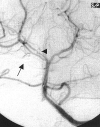Saccular aneurysm associated with posterior cerebral artery fenestration manifesting as a subarachnoid hemorrhage in a child
- PMID: 12223367
- PMCID: PMC7976247
Saccular aneurysm associated with posterior cerebral artery fenestration manifesting as a subarachnoid hemorrhage in a child
Abstract
Fenestrations of the cerebral arteries are uncommon, and aneurysms in association with fenestrations are even more uncommon. We report the case of a saccular aneurysm associated with a posterior cerebral artery fenestration in a child with subarachnoid hemorrhage. The patient was successfully treated with Guglielmi detachable coils. This case is unusual because of the patient's age and the location of the fenestration.
Figures




References
-
- Takahashi M, Tamakawa Y, Kishikawa T, Kowada M. Fenestration of the basilar artery: report of three cases and review of the literature. Radiology 1973;109:79–82 - PubMed
-
- Teal JS, Rumbaugh CL, Bergeron RT, Segall HD. Angiographic demonstration of fenestrations of the intradural intracranial arteries. Radiology 1973;106:123–126 - PubMed
-
- Hoffman WF, Wilson CB. Fenestrated basilar artery with an associated saccular aneurysm: case report. J Neurosurg 1979;50:262–264 - PubMed
-
- Wollschlaeger G, Wollschlaeger PB, Lucas FV, Lopez VF. Experience and result with postmortem cerebral angiography performed as routine procedure of the autopsy. Am J Roentgenol Radium Ther Nucl Med 1967;101:68–87 - PubMed
Publication types
MeSH terms
LinkOut - more resources
Full Text Sources
Medical
